Tressette is a four player
trick-taking card game, usually played by two partnerships
consisting of two players each. Although the
game originated in Italy, it is also widely played in many other locations including Croatia, Montenegro and Albania, albeit under a slightly different name. Some of the alternate names by which this game is sometimes known are Tresett, Trešeta, and Terziglio although this last name is more commonly used for a different game as described on this
Calabrasella game page.
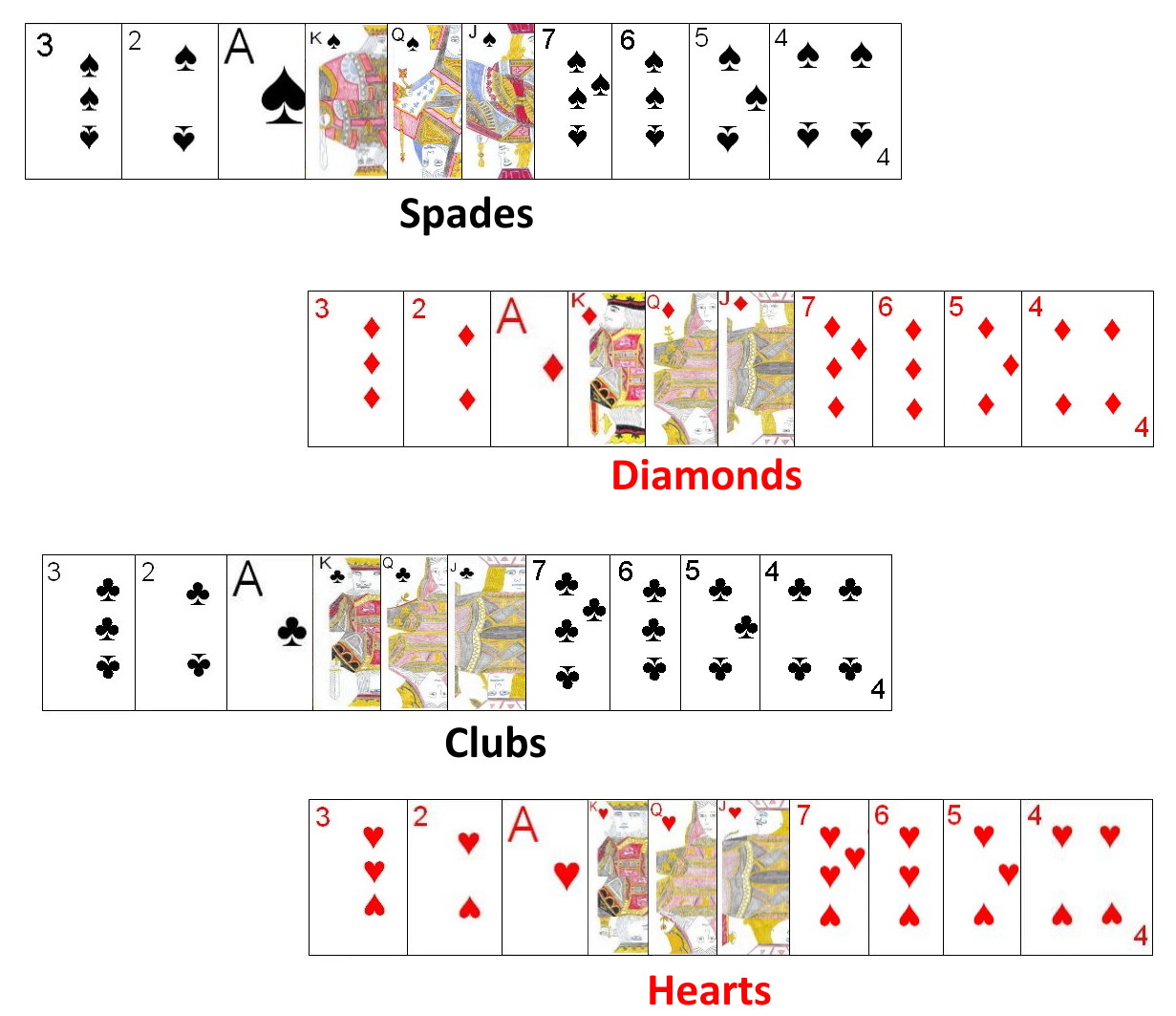 |
| Tressette is traditionally played with a Spanish deck, however if such a deck is not at hand, it can be played using a Modified French deck, as shown in this diagram. |
Tressette is usually played with the traditional 40 card Italian deck. This deck, which is also sometimes called the Spanish deck consists of one card in each of four suits in the following denominations; Ace, King, Knight, Knave, 7, 6, 5, 4, 3, 2. However, if such a deck is not handy, this deck can also be created by removing certain cards from the standard 52 card French deck. To do this, starting with a standard French deck, all cards in the denominations of 8, 9, and 10 should be removed from the deck. The ranking of the individual denominations as used in this game are as follows (from high to low): 3, 2, Ace, King, Knight (Queen), Knave (Jack), 7, 6, 5, 4.
Although more commonly played as a partnership game, Tressette can also be played cutthroat, with the rules for individual play described in the variations section below. Determination of partnerships, seating positions, and the first dealer can be performed using a variety of methods. One common method is for each player to draw a card from the face-down shuffled deck. The two players drawing the highest cards would play as partners against the players drawing the two lowest cards (using the expected ranking of cards for this game). If two or more players draw cards of the same rank, those players would discard and draw new card, again redrawing if drawing cards drawn by any other player. The player who draws the highest card of all is set as the first dealer and would have first choice of seats at the table. His partner should sit directly opposite him at the table. The members of the opposing team would then fill the two remaining vacant seats, and all should be seated in such a way that each player has
a member of the opposing partnership to his immediate right and left.
Once the players are seated, the first dealer should then take the deck and thoroughly shuffle it. The opponent at his immediate left would cut the deck and after the cut, the dealer would then begin distributing the cards in a counter-clockwise direction around the table, starting with the player at his right. He deals the cards, in five card packets, face-down in front of each player. He continues dealing these packets until the entire deck of 40 cards is dealt, which should leave each player with 10 total cards.
After the cards have been dealt, gameplay starts with the player to the immediate right of the dealer, who leads the first card to start the first trick of the game. The leader to a trick may play any card of choice from his hand to start a trick. Each remaining player, in a counter-clockwise direction then plays one card from his hand to that same trick. If he has a player of the suit led to start that same trick he must play such a card. If he has no card of the suit originally led to the trick, he may play any card from his hand to the trick. Each card to the trick is played face-up to the table in proper turn.
After each player has played one card to the trick, it is examined to determine which player has won the trick. The player of the highest card of the same suit as originally led to that trick wins the trick. That player then takes the cards from the trick and sets them in a face-down pile, out of play, for scoring at the end of the hand. The winner of each trick then leads the first card to the next trick, with the same rules used as for the first trick.
Special Combinations: There are special combinations of cards which a player may have in the hand which earn bonus points for that player's partnership. The following chart shows all these special combinations:
| Combination | Point Scoring Value |
|---|
| A three, two, and Ace, all of the same suit (called a Napoletana) | 3 |
| Three 3's OR Three 2's OR Three Aces | 3 |
| Four 3's OR Four 2's OR four Aces | 4 |
|
|
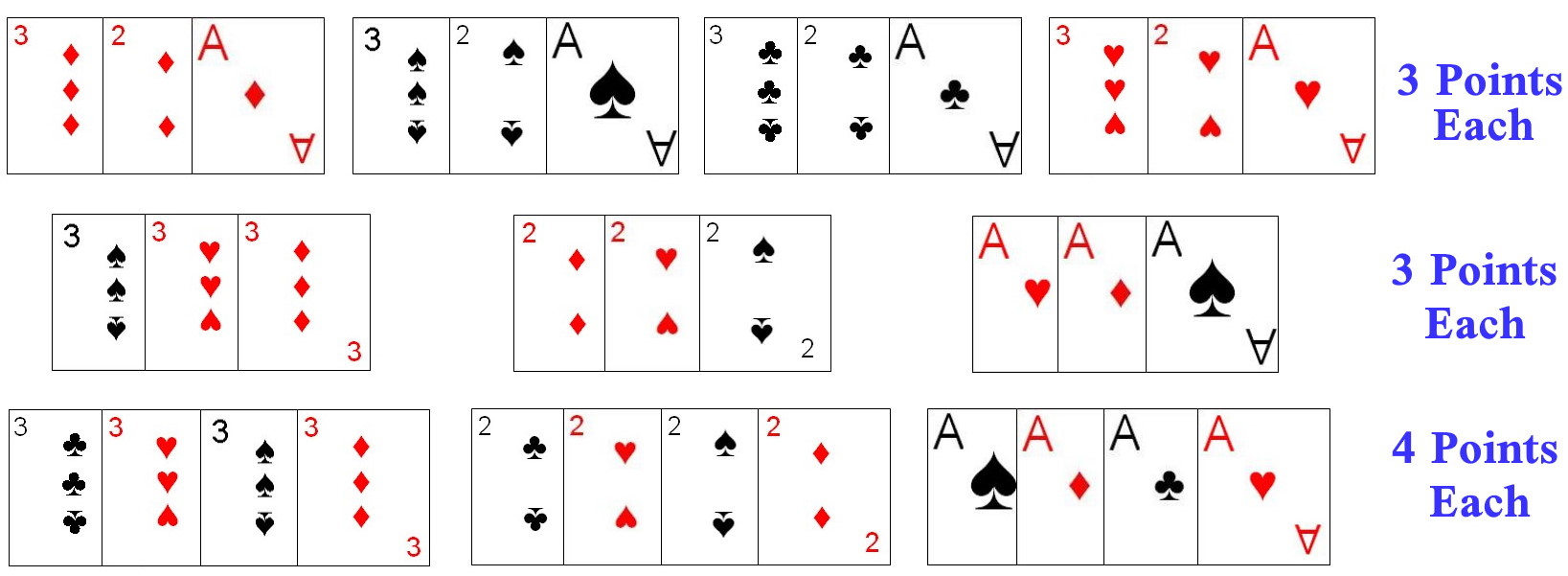 |
In order to score for the combination, a player must announce his
combination after completion of the first trick. The combination need not
be shown to the opponents but must be described what suits or cards it
contains. A player may announce and score for multiple combinations if he
has more than one scoring combination. He may also announce and score for a combination regardless if he played one of the cards from the combination to that first trick. These bonus points are added to that partnership's score immediately upon declaring the combinations.
After all 10 tricks have been played and won, additional scoring occurs. Certain cards in the deck have a specific point value, as shown on the following chart:
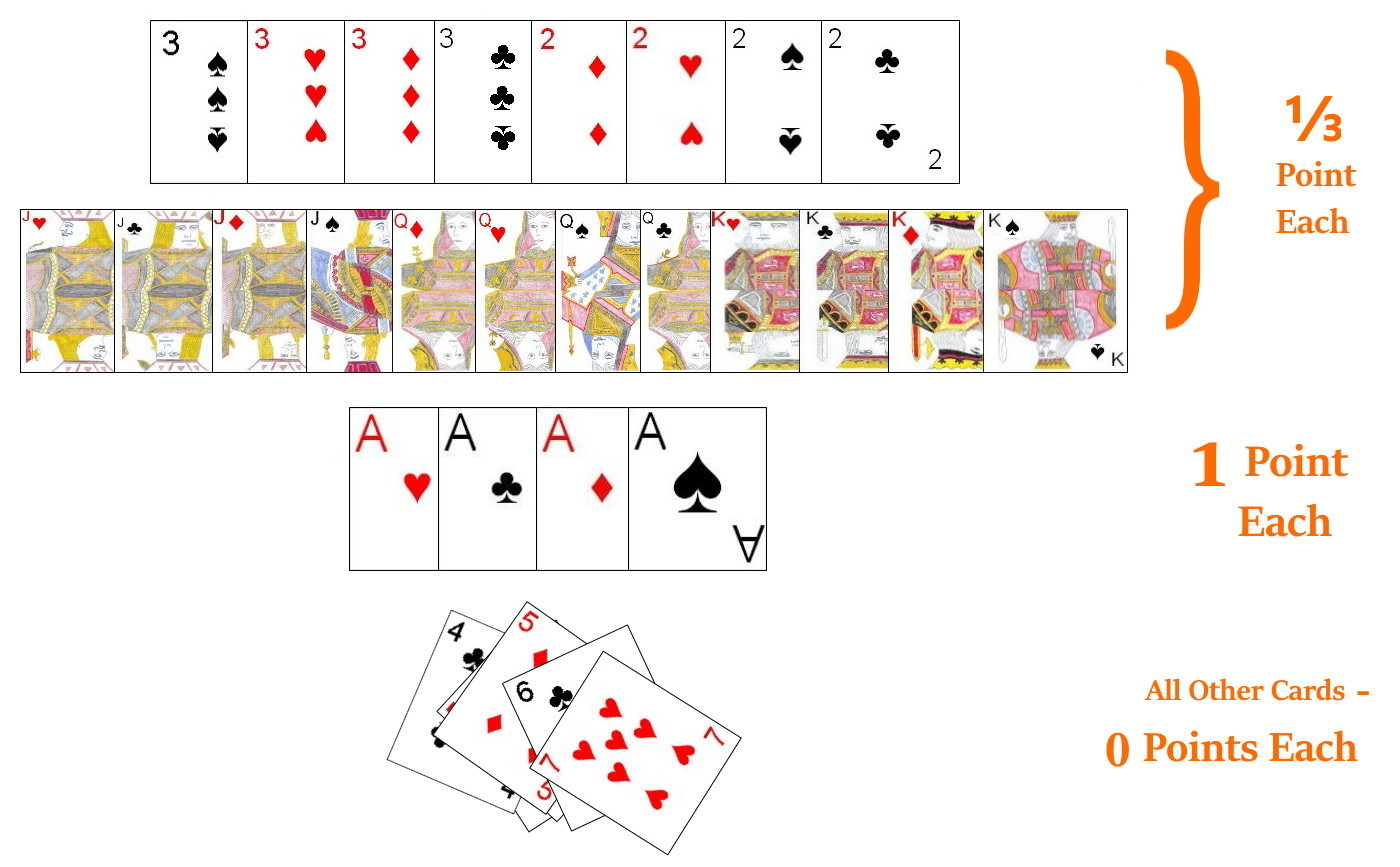 |
|
| Card | Point Value |
|---|
| 3, 2, King, Queen, Jack | 1/3 of a Point Each |
| Ace | 1 Point Each |
| 7, 6, 5, 4 | 0 |
|
In addition to these points, the partnership which manages to win the last trick of each hand earns 1 point.
Each partnership thus combines all the cards won by that partnership and sorts through these won cards, adding the total number of points in captured cards. This number of points is added to that partnerships score. However, any fractional amounts in this final total are dropped, as each hand must end with a partnership having a whole number of accumulated points. As an example if a partnership ended a hand with 8 2/3 points, this score would be adjusted down to 8.
If neither partnership has managed to score 21 or more total accumulated points after the last hand, another hand is dealt, with the next player in a counter-clockwise direction from the last dealer set as the dealer for the next hand. However, if one or both partnerships manage to score 21 or more accumulated points at the end of a hand, the game ends, with the partnership having the higher score declared the winner. Furthermore, if a player from a partnership, during play of the hand, believes his partnership has scored enough points, up to the current time, to reach 21 or more points he may declare this. In this event, play immediately stops, each team calculates the points won during the current hand. If the partnership consisting of the player who made the announcement does indeed have 21 or more points, they are immediately declared the winner (regardless of the current score of the opponents), however if they have less than 21 points the opponents are the victors (regardless of how many points that partnership currently has earned).
There are a few special methods by which a partnership can instantly win the entire game, described as follows:
- If one partnership manages to win all 10 tricks during a hand, they instantly win the game. This is called Cappotto.
- If one team does not win every trick in that hand but manages to win 10 or more points (not counting the point for the last trick), that team instantly wins the game. This is called Stramazzo.
Longer game sessions are usually kept track of through the use of Game Points, with teams earning Game Points for winning games. Winning a game of Tressette earns each player in that partnership one Game Point. However, more game points may be awarded by a team for special win conditions:
- Winning by Cappotto, as described above, earns each player in that partnership 2 Game Points instead of 1.
- Winning the game by Stramazzo, also as described above, earns each player in that partnership 3 game points vice just 1.
- If one player wins all 10 tricks, both members of that player's partnership earn 6 game points for the feat (called Cappottone).
- If one player manages to win at least 10 points from point scoring cards during one hand (called Stramazzone), both members of that player's partnership earn 8 game
points.
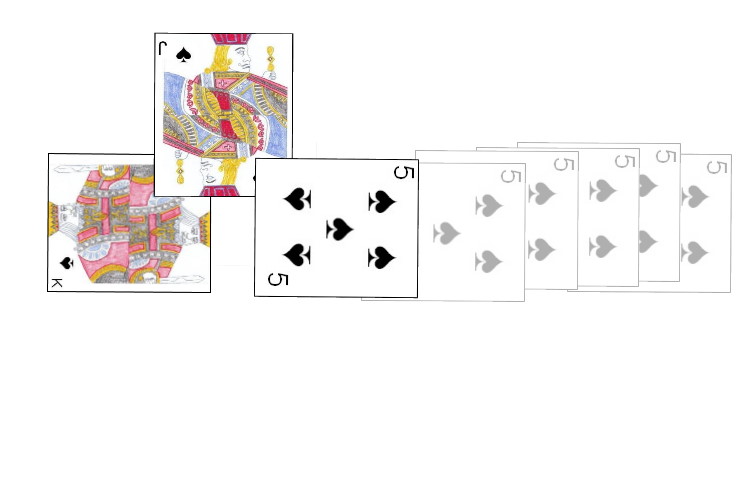 Signaling:
Signaling: Traditionally the game is designed in that normal verbal communication regarding anything relating to the game or hand is forbidden between the partners during play. However, it is also tradition and acceptable that certain
signaling or verbal cues are allowed (and of course well known by all players). The following are the normally allowed such signals, which are all performed as the
signaler plays a card to a trick:
- Knocking on the Table with the knuckles or saying "Busso": This is a
signal used to notify your partner that you want him to play his highest
card, on the current trick, of the same suit as played by the knocking player. If that player wins the trick, it also indicates you want the player to lead that same suit to the next trick, as able.
- Saying "Volo" or throwing the card to be played to the current trick on the table: This is a signal indicating to that player's partner that this player has no more cards in the suit originally led to this trick.
- Saying "Striscio" or sliding the card to be played to the current trick onto the table: This signal is intended to indicate to one's partner that, in addition to the card currently played, this player has one or two other lower cards (lower than Ace) in the same suit as originally led to this trick.
Individual Play: Tressette is sometimes played individually, in which each of the four players plays for himself. The rules of the game are the same as in the partnership version as described above, however, each player scores only for cards he himself has earned and any Game Points earned at the end of each game are only attributed to the winning player. Obviously, also, no
signaling is done as each player is playing independently.
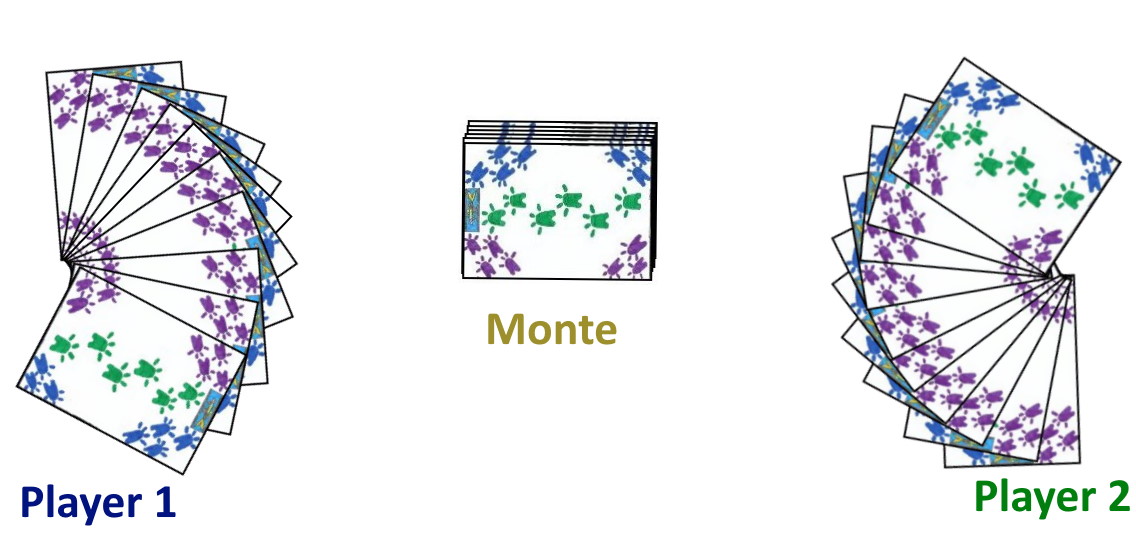 Two Player Tressette (Tressette en Due)
Two Player Tressette (Tressette en Due): Tressette can also be played by two players using similar rules
(called Tressette en Due). The rules for the two player variant are the same as the four player versions of the game with the following exceptions:
- During the deal, each player still is dealt a total of 10 cards. The remaining 20 cards are placed in the center of the table as a face-down draw pile (called the monte).
- After each trick, while cards still remain in the monte, each player draws one card from the top of the draw pile. The winner of the trick draws first and his opponent draws next. As each player draws his card, he must first show it to his opponent before adding it to his own hand.
- The declaration and scoring of special combinations is done somewhat differently in this two-player variant. In this variant, a player does not declare (and score for) a combination until he actually plays one of the cards of that combination to the table. As he plays this card, he announces the combination and may
then score for it. Besides the card played to the trick, the player must have all other cards comprising that combination currently in his hand. This may be done during any trick of the hand on that player's turn to play to a trick. A player may also announce and score for the same type of combination multiple times during a game, as long as they play one card from the announced combination (and
still retain the other necessary cards for the combination in the hand) upon the announcement of the combination.
- As each player is playing independently, each player scores for himself in both points during the game as well as any Game Points awarded at the end of each game.
In all other aspects Tressette en Due is played identically to the standard four player versions previously described.
Tressette con la Chiamata del Tre: Tressette con la Chiamata del Tre is played very similarly to standard Tressette, however the main difference is how partnerships are determined for each hand. At the start of the game players can
take any seat they want at the table, as it will be unknown at that time which players will be designated partners during any specific hand. After the cards are dealt, the player to the immediate right of the dealer examines his hand and determines the highest card he does not currently have in his hand (usually a 3). He announces this card aloud and whichever player has that card becomes that players partner for the current hand. However, this player does not announce this fact, and the identify of the player's partner will usually remain unknown until the called card is played. Thus, the player who called the card and the player having the called card play as partners against the other two players, although the exact identity of the partnerships will probably remain unknown for some time. Players remain in their current seating positions for the hand, regardless of which other player is that player's partner.
Each player scores the total number of points earned by his partnership during that hand. At the end of a specific game session the player with the highest grand total is declared the game winner.
In all other aspect Tressette con la Chiamata del Tre is played identically to the standard variant as described above.
Mediatore: Mediatore is a variation of Tressette which features a round of simple bidding which determines the potential partnerships for that hand. Since partnerships (if any) have the capability to change on every hand, there is no determination of partnerships before the game. The players should use the normal procedures for determining seating positions and the first dealer,
however. As in standard Tressette, Mediatore is designed for four players. The ranking of the cards and the point values of each card is the same as in standard Tressette.
Once the dealer has been determined he should deal the cards in a counter-clockwise direction, in face-down packets of three, starting with the player at his immediate right. He continues dealing until each player has nine total cards. This should leave four cards remaining in the stock, which he should place face-down in the middle of the table as the monte.
After the deal each player then picks up his cards for examination, after which there is a round of bidding. The player to the dealer's immediate right has the first opportunity to bid and the bidding continues in a counter-clockwise direction around the table. In order to be considered a valid bid, a player must make a bid which is higher than any previous bid. A player may also elect to pass (indicating this by saying "passo"). The following are the bids, shown in ascending order from lowest to highest along with a brief description of each game type
represented by that bid:
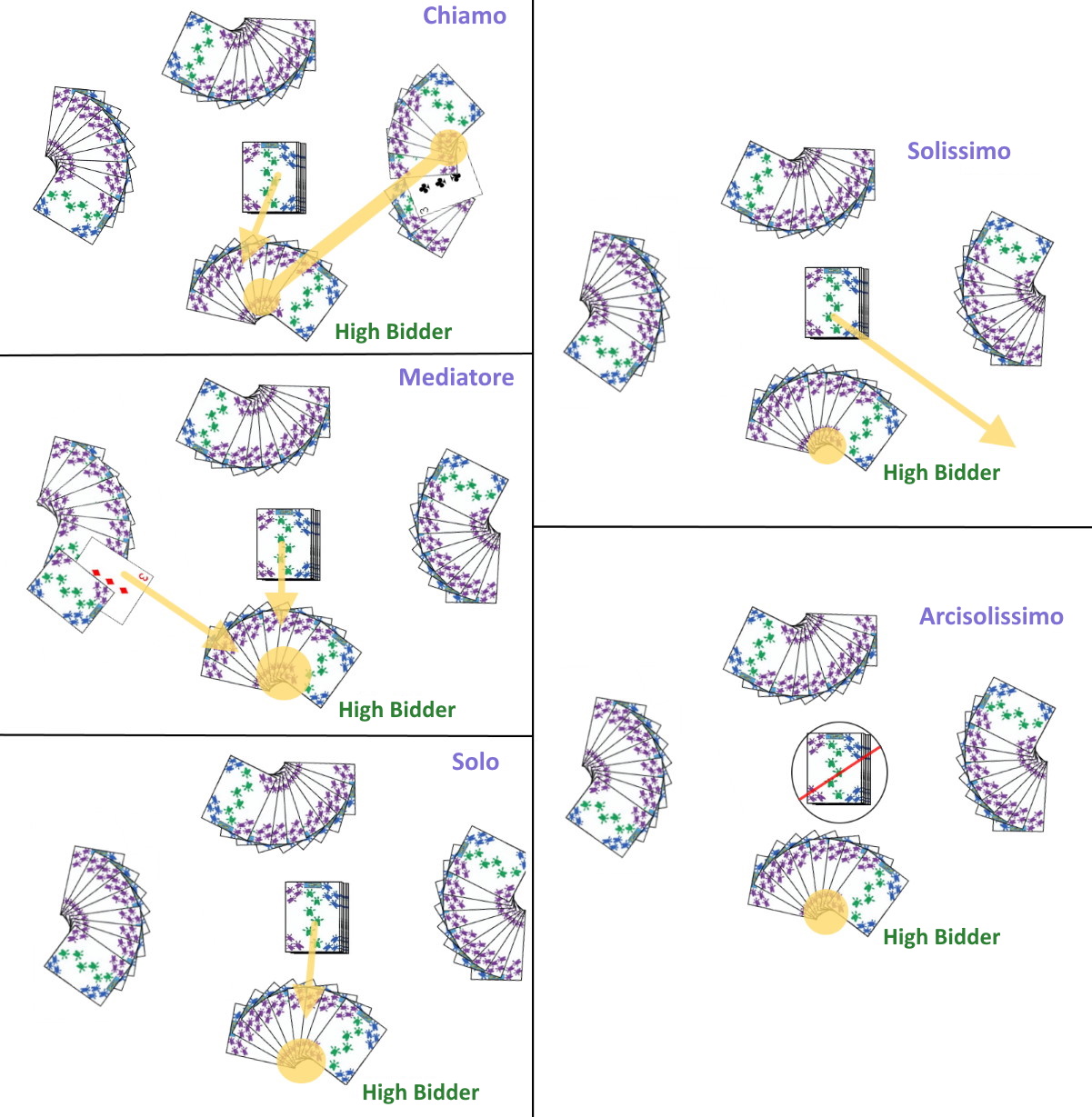
- Chiamo:
Chiamo is the lowest bid and indicates the player is bidding to play the hand with one partner (which will be unknown at the start of the hand). If this becomes the high bid during the hand, the high bidder of Chiamo will name a high card (by rank and suit) he does not have in his hand (usually a three). Whichever other player has the called card is then set as the partner of this player during the hand. However the player who does have the card does not announce this fact, and thus it will most probably remain unknown who the players partner is until the called card is played during a trick. If the called card is not found in another player's hand (usually because it was found in the monte), the Chiamo
bidder will play the hand without the aid of a partner. After the high bidder calls for the high card, he then picks up the monte and adds those cards to his hand. He then discards any four cards from his hand, setting them aside until the last trick of the hand.
- Mediatore:
This is the second lowest bid which can be called. A Mediatore bid is a bid to play alone, however the bidder has the right to the cards in the monte and a high card of which he calls for. If Mediatore ends up the as the high bid for the hand, the player who makes this bid may name any high card not currently found in his hand (usually a three). Whichever other player has this card must then pass this card to the high bidder. The high bidder than exposes the monte momentarily on the table for all to see and then adds these cards to his hand. He passes any one card of choice to the player who passed him the called high card and then discards four cards, face-down to the side, which are then out of play for the current hand. If no other player has the card called
for by the Mediatore bidder, he simply exposes the monte and adds it to his hand, then discards any four cards from his hand, with these cards set aside until the last trick.
- Solo:
A bid of Solo is a bid to play with no partner and the
player making this bid does not have the opportunity to call for a high card. If this becomes the high bid, the bidder exposes the monte on the table for all the players to see. He then adds the cards from the monte into his hand and discards any four cards from his hand to the side, with those cards out of play until the last trick of the hand.
- Solissimo:
A bid of Solissimo is similar to a call of Solo, but is
considered the next highest bid. If this bid becomes the high bid, the
Solissimo bidder may himself look at the monte and is not required to show
it to any of the other players. He may not use the cards from the monte and
after reviewing those cards, he sets them aside, where those cards remain out of play until the last trick.- Arcisolissimo:
Arcisolissimo is the highest allowable bid in this game. If Arcisolissimo becomes the high bid for the hand, the high bidder plays alone and no player may see the cards of the monte, including the high bidder. The cards in the monte are set aside, seen by no one until the last trick of the hand.
The bidding continues until a high bid is followed by three consecutive passes. The player making the highest bid then becomes the bidder for the hand and plays the hand as indicated by his bid. If all four players initially pass, the cards are thrown in with no play or scoring and the next dealer in turn, shuffles and redeals.
Once the high bidder has bee determined, the play of the hand begins. The player to the dealer's immediate right plays the first card to the first trick and each player in turn, in a counter-clockwise direction contributes one card from the hand to the same trick.
The leader to each trick may play any card remaining in his hand to start the trick. Each other player to that same trick must play a card of the same suit as originally led to the trick if he has one. However, if the player has no card of that same suit, he may play any card to the trick.
After each player has played one card to the trick it is determined who won the trick. The player who played the highest card of the suit originally led to the trick wins the trick. The cards from the trick are set aside out of play by that player, for examination at the end of the hand for scoring. The winner of each trick leads the first card to start the next trick. The winner of the last trick is also awarded with the four cards set aside at the start of the hand, these cards being either the monte or the cards discarded by the high bidder from his hand
in exchange for cards from the monte.
Mediatore allows the same types of signals to be used by a player to indicate to his partner certain information about his hand as are used in the parent game of Tressette.
After the last trick has been played to and won, the partnerships combine all the cards won by each player in that partnership and determine the total number of card points won during the hand. The cards as won in tricks have the same point scoring value as in standard Tressette. The partnership that manages to win 6 or more points has won the hand. As in Tressette and many other games, each game won earns the players in that team each a number of Game points, dependent on the declared high bid for the hand:
- If Chiamo was the high bid and the bidding partnership wins the hand, each member of the opposing partnership loses four game points, the winning high bidder earns five game points and his partner earns three. If the high bidder had played alone (the card called was not in any other players hand), the high bidder earns 12, and each opponent earns 4 points each. If, however, the high bidders team does not manage to win the hand, the high bidder loses five game points, his temporary partner for the hand loses three and each opponent earns four. However, if the high bidder played alone, he loses 12 points and each of the opponents earns 4 Game Points.
- If Mediatore was the high bid for the hand, and the high bidder manages to win that player earns either 22 or 24 points, depending on if the card called was provided by another player or not. If the called card was passed from another player, the high bidder wins 22 Game Points total, the player who passed the high bidder the card loses six Game Points and the other two players lose eight points each. However, if the called card was found in the monte, and thus no other player had the card, the high bidder wins 24 points, and each other player loses eight points each.
- If Solo was the high bid and the high bidder manages to win the hand, that player earns 36 Points and each opponent loses 12. However, if the high bidder does not win the hand, the high bidder loses 26 and each opponent earns 12 each.
- In the event Solissimo is the high bid and the bidder wins the hand, he earns 48 points total and each opponent loses 16. However, if the bidder does not win the hand, he loses 48 instead and each opponents earns 16.
- If Arcisolissimo is the high bid for the hand and the bidder wins the hand, that player earns 54 total Game Points and each opponent loses 18. However, if the high bidder does not win the hand, he loses 54 Game Points instead and each opponent loses 18.
- If one team manages to win every trick in the hand (called Cappotto), the points earned or lost are increased by 2 Game Points per opponent participating in the game.
In all other aspects Mediatore is played identically to standard Tressette.
Trešete: Trešete is the variant of Tressette which is most commonly played in Dalmatia and along much of the coast of Montenegro. It is played very similarly to the standard game with only a few minor differences. The major difference being that the point requirement for winning the game is 41 points vice 21
as in the standard game. Another difference is that, particularly as played in Dalmatia, the rotation of play, the deal and role of dealer is clockwise instead of counter-clockwise as is usually found for this game in most other locales. In all other aspects this game is played identically to standard Tressette as described above.
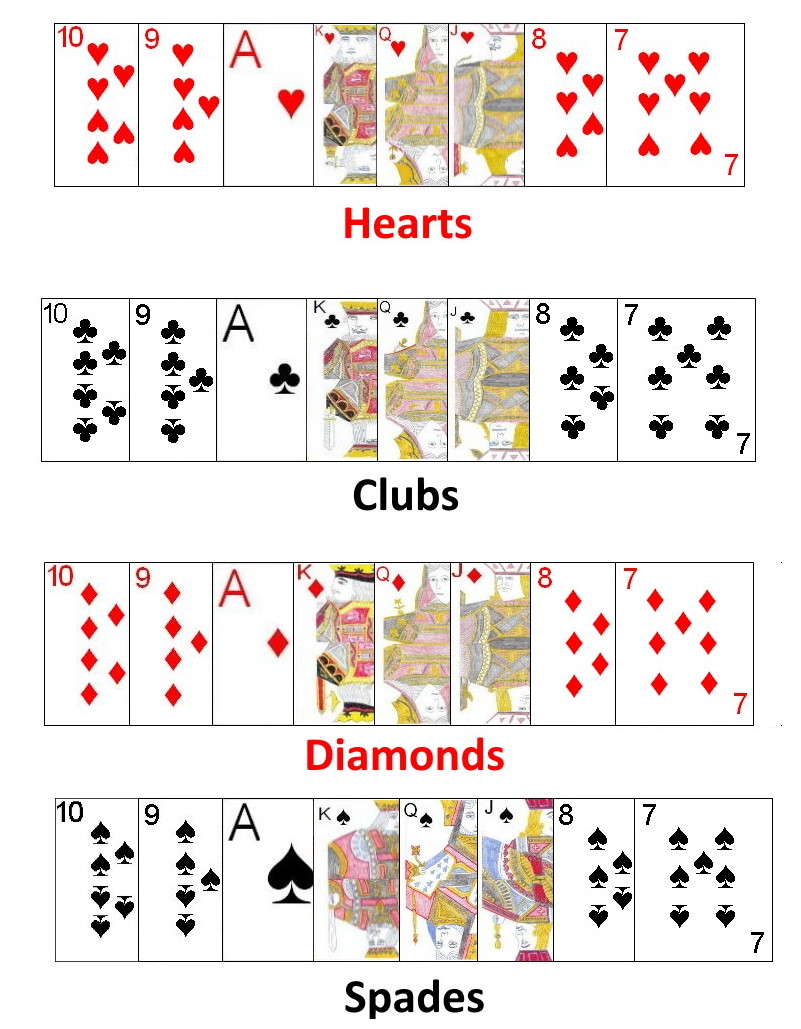 Trischettn
Trischettn: Trischettn is an Austrian variant of Tressette which is mostly played in the South Tyrol area of Italy. It is believed to be of Austrian descent as this variant is traditionally played using the 32 card German deck. This game is also known as Treschetten. Treschettn is designed to be played by two players.
The German deck as would be so used for this game usually consists of
four suits, with four cards in each of the following denominations: 7, 8, 9, 10, Unter (equivalent of the Jack), Ober (equivalent of the Queen), King, and Ace. If such a traditional German deck is not at hand, this can be formed by removing all cards lower than rank 7 from a standard French deck. The ranking of the cards as used in the game Trischettn is as follows (from high to low): 10, 9, Ace, King, Ober (Queen), Unter (Jack), 8, 7.
As in standard Tressette, each card in the deck has an equivalent point value for it's capture in a trick. The following chart shows these point values:
| Card | Point Value |
|---|
| 10, 9, King, Queen (Ober), Jack (Unter) | 1/3 of a Point Each |
| Ace | 1 Point Each |
| 8, 7 | 0 |
After seating positions and first dealer have been determined the game can begin. The designated dealer for the hand then deals each player a total of 8 face-down cards. The remainder of the undealt deck is placed face-down in a stack in the middle of the table as the talon.
The opponent of the dealer leads the first card to the first trick, and his opponent then plays a card from his hand to complete the trick. In leading to a trick a player may play any card remaining in his hand. In playing to an existing trick, a player must play a card of the same suit as originally led to the trick if he has one. If he does not have such a card he may play any card from his hand. The player who played the highest card of the suit originally led to the trick wins the trick, taking the cards from the trick and setting them aside face-down for use in determining the score at the end of the hand. The winner of the trick draws the top card from the talon and his opponent then draws the next. Once the talon is exhausted, players will simply complete the hand using the cards remaining in hand. The leader of each trick leads the first card to the next trick.
If a player has previously won at least one trick during the current, and on his turn to lead, he may make a declaration. This declaration will earn that player a certain number of bonus points based on the declaration as follows:
- Three cards of the same rank (either three 10's, three 9's, or three Aces), earns a player 3 bonus points.
- Four cards of the same rank (either four 10's, four 9's, or four Aces), earns the declaring player 4 bonus points.
- One ten, one nine and one Ace, all of the same suit earns the player 3 points. This is called a Nappelle or Napoli.
Note that a player can not declare the exact same declaration using the exact same cards more than one a hand, he can use the same card in multiple declarations, even going so far as to declare three cards of the same
denomination and on a later turn declaring a four card combination of that same denomination.
At the end of each hand, each player adds to his ongoing accumulated score a number of points based on the card points he managed to capture as well as any declarations he announced during the hand. In addition, winning the last trick of the hand earns that player 1 additional point. Only whole numbers can be scored so any fractional points, at the end of a hand are lost.
The game continues for a number of hands until one player manages to score 31 or more points during a hand, at which time he is declared the winner. Oftentimes, two games are played to determine a winner. If each player managed to win one game, a third and final game is played, this time the necessary score to win is raised to 41 points.
Ciapanò:
Ciapanò is a unique variant of Tresette in which the goal of the game is quite the opposite of that in the standard game of Tresette. Thus, in Ciapanò the players attempt to avoid winning the point scoring cards. This game also is commonly played under the names Tressette a non Prendere, Rovescino, Vinciperdi, Perdivinci and Traversone.
Ciapanò is designed for play by 3, 4 or 5 players, each playing independently. Like Tressette, the game is usually and traditionally played using the Italian card deck. However, if such a deck is not at hand, a standard French deck will suffice, removing all cards of ranks 8, 9 and 10, leaving a 40 card deck. The ranking of cards as found within this deck are as follows (from high to low); 3, 2, Ace, King, Queen, Jack, 7, 6, 5, 4. Each card in the deck has a point value earned for capturing that card in a trick. This point value is the same as in standard Tressette:
| Card | Point Value |
|---|
| 3, 2, King, Queen, Jack | 1/3 Point Each |
| Ace | 1 Point Each |
| 7, 6, 5, 4 | 0 |
Also as in the parent game, winning the last trick earns the player who wins it a certain number of points, as described further below.
Determination of seating positions and the first dealer can be performed using the same methods as might be used for standard Tressette, with draw for high cards a common method. Each player would draw a card from the shuffled deck, and would set themselves at the table in the order of cards dealt, starting with the highest drawn and continuing to the lowest such card drawn. If multiple players draw cards of the same denomination, those players should discard and continue redrawing until drawing cards of a denomination not previously drawn by any other player. The player drawing the highest card of all is set as the first dealer. After each hand, the role of dealer rotates in a counter-clockwise direction around the table.
The dealer should thoroughly shuffle the cards and offer the deck to the player at his left to cut. After the cut, the dealer begins dealing the cards around the table, starting with the player at his right and continuing in a counter-clockwise direction. The specific number of cards dealt will vary based on the number of current players in the game. With five players each player will receive 8 cards, with 4 players each will receive 10 cards, and with 3 players each will receive 13 cards.
It should be noted that in the 3 player variant, there will be one card remaining after each player has received the requisite number of cards. In this case, this last card is dealt to the dealer, who will then, immediately after the deal, review his hand, and select any one card from his hand and place it face-down to the side, temporarily out of play. The winner of the last trick during the hand will also take this card with the
cards from that trick.
Play of the hand begins with the player to the right of the dealer playing the first card to the first trick. Each other player in a counterclockwise direction from that player then plays one card of choice remaining in his hand to the same trick, until each player has played one card to the trick.
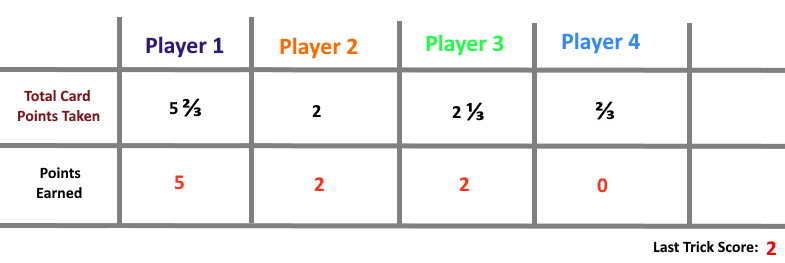 |
| The last trick in Ciapanò has a point value based on the total number of points scored during the hand by all players. |
The leader to a trick may play any card of choice from his hand. Each other player to that same trick must play a card of the same suit as originally led to that suit if he has such a card. If he has no cards of the suit originally led to the trick he may play any other card from his hand. The trick is won by the highest card of the suit originally played to the trick. The cards from the trick should be set aside for scoring for the player winning it, at the end of the hand. The leader of each tricks leads the first card to the next trick.
After all tricks have been played and won, the players sort through the cards won in tricks to score the hand as per the card values indicated in the chart above. Thus, each player would add to his current total accumulated score, an additional number of points based on the total card points captured during the current hand. However, only a whole number of total points can be scored, so any remaining fraction of a point is not counted (as an example, a player who captures 5 1/3 totaled points for the hand would score 5 points for that hand).
As briefly mentioned above, the winner of the last trick of each hand also earns a number of points. This number of points is based directly on the total number of points scored by all players
during the hand (after shaving off any remainder fractions) subtracted from 11. Thus, if the total of all the players scored during the hand ends up as 8 points, the winner of the last trick would score 3 points for the last trick (added to any other card points he might earn during that hand).
In the special event that one player manages to win all the point scoring cards during a hand, this is called Cappotto. In this case, that player who captured every point scoring card during the hand scores 0 points and each opponents scores 11.
At the end of any hand, if any player reaches or exceeds 31 accumulated total points, that player must drop from the game. The game continues with the remaining players in this way until only 1 player remains, with that player declared the overall game winner.
In this variant, the entire deck is dealt out, such that each player is dealt nine cards to his hand and four face-up cards are dealt to the center of the table.
The game proceeds as in the standard game, however each player will play from his larger hand until all cards have been played and scores are calculated for the hand.
Copyright © 2015
CatsAtCards.com. All rights reserved.



 Signaling: Traditionally the game is designed in that normal verbal communication regarding anything relating to the game or hand is forbidden between the partners during play. However, it is also tradition and acceptable that certain
signaling or verbal cues are allowed (and of course well known by all players). The following are the normally allowed such signals, which are all performed as the
signaler plays a card to a trick:
Signaling: Traditionally the game is designed in that normal verbal communication regarding anything relating to the game or hand is forbidden between the partners during play. However, it is also tradition and acceptable that certain
signaling or verbal cues are allowed (and of course well known by all players). The following are the normally allowed such signals, which are all performed as the
signaler plays a card to a trick:



